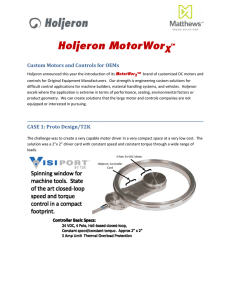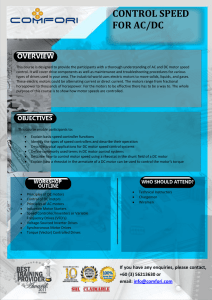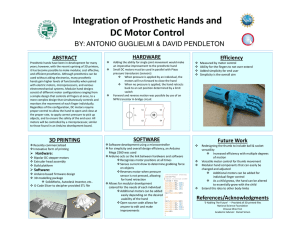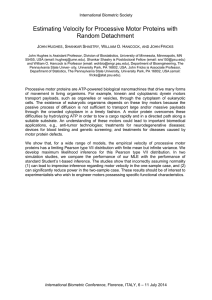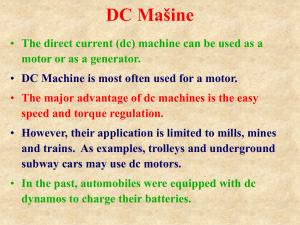“Super Premium” Efficiency Motors are Now Available
advertisement
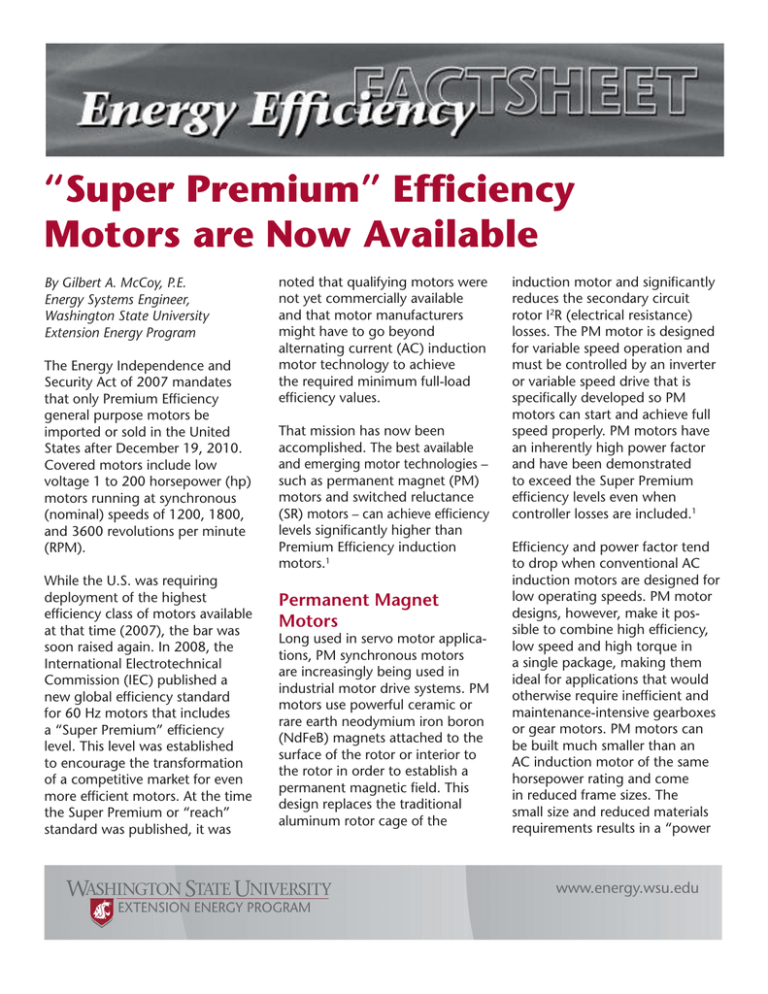
Energy Efficiency Factsheet: “Super Premium” Efficiency Motors • Page 1 “Super Premium” Efficiency Motors are Now Available By Gilbert A. McCoy, P.E. Energy Systems Engineer, Washington State University Extension Energy Program The Energy Independence and Security Act of 2007 mandates that only Premium Efficiency general purpose motors be imported or sold in the United States after December 19, 2010. Covered motors include low voltage 1 to 200 horsepower (hp) motors running at synchronous (nominal) speeds of 1200, 1800, and 3600 revolutions per minute (RPM). While the U.S. was requiring deployment of the highest efficiency class of motors available at that time (2007), the bar was soon raised again. In 2008, the International Electrotechnical Commission (IEC) published a new global efficiency standard for 60 Hz motors that includes a “Super Premium” efficiency level. This level was established to encourage the transformation of a competitive market for even more efficient motors. At the time the Super Premium or “reach” standard was published, it was noted that qualifying motors were not yet commercially available and that motor manufacturers might have to go beyond alternating current (AC) induction motor technology to achieve the required minimum full-load efficiency values. That mission has now been accomplished. The best available and emerging motor technologies – such as permanent magnet (PM) motors and switched reluctance (SR) motors – can achieve efficiency levels significantly higher than Premium Efficiency induction motors.1 Permanent Magnet Motors Long used in servo motor applications, PM synchronous motors are increasingly being used in industrial motor drive systems. PM motors use powerful ceramic or rare earth neodymium iron boron (NdFeB) magnets attached to the surface of the rotor or interior to the rotor in order to establish a permanent magnetic field. This design replaces the traditional aluminum rotor cage of the induction motor and significantly reduces the secondary circuit rotor I2R (electrical resistance) losses. The PM motor is designed for variable speed operation and must be controlled by an inverter or variable speed drive that is specifically developed so PM motors can start and achieve full speed properly. PM motors have an inherently high power factor and have been demonstrated to exceed the Super Premium efficiency levels even when controller losses are included.1 Efficiency and power factor tend to drop when conventional AC induction motors are designed for low operating speeds. PM motor designs, however, make it possible to combine high efficiency, low speed and high torque in a single package, making them ideal for applications that would otherwise require inefficient and maintenance-intensive gearboxes or gear motors. PM motors can be built much smaller than an AC induction motor of the same horsepower rating and come in reduced frame sizes. The small size and reduced materials requirements results in a “power Energy Efficiency Factsheet: “Super Premium” Efficiency Motors • Page 2 dense” machine having a torqueto-weight ratio about twice that of conventional AC induction motors with a weight savings of nearly 50 percent.2,3 Due to their light weight, high torque, and low inertia, PM motors are often specified for electric vehicle hub motor drives and for regenerative elevator drives. Industrial applications for which PM motors are suitable include adjustable speed pumps, fans and compressors, plus extruders, conveyors, crane and hoist systems, pumps, winders and printing presses. Baldor Electric currently offers 1800 RPM totally enclosed blower-cooled PM motors and controllers in the 10 hp to 150 hp size range as standard product offerings. Compact, low speed Courtesy of Baldor Electric 倀䴀 倀 爀攀洀椀甀洀 䔀 昀昀椀挀椀攀渀挀礀글 䤀䔀 䔀 䔀 㠀㐀 䔀 渀攀爀最礀 䔀 昀昀椀挀椀攀渀琀 㤀㠀 㤀㘀 ─ 䔀 䘀 䘀 䤀䌀 䤀䔀 一䌀 夀 For small motor sizes, the efficiency of the PM motor may increase by 10 to 15 percent when contrasted with older standard efficiency motors at the same load point.4 The relative full-load efficiency of PM versus energy efficient and NEMA Premium Efficiency motors of various horsepower ratings is shown in Figure 1. These efficiency gains hold over the entire range of typical motor loads. While PM motors require additional costs for their rotor magnets, their light weight means that they have greatly reduced steel and copper costs relative to a Premium Efficiency motor. Some manufacturers have established rating equivalent pricing strategies such that PM motors are now cost-effective when compared to a conventional Premium Efficiency motor and adjustable speed drive (ASD) combination.1 Figure 1 Full-Load Efficiency Values for PM Versus NEMA Premium Efficiency Motor Models 㤀㐀 㤀㈀ 㤀 㠀㠀 㠀㘀 䠀倀 pancake designs are available for specialty applications such as cooling tower fan motors. For additional information, contact Rich Schaefer, Baldor Electric Company, (864) 382-2722. Rrschaefer@baldor.com Switched Reluctance Motors Like the PM motor, a switched reluctance (SR) drive system requires both a motor and an electronic power converter or controller that controls both torque and speed. The controller eliminates low speed cogging (jerky motion) by switching motor phases on and off in relation to the rotor position. The motor cannot be used without the converter and cannot be used with a conventional variable frequency drive or inverter. Unlike the PM motor, the Super Premium efficiency SR motor has a rotor that does not have magnets, rotor bars or windings. The rotor is essentially a piece of shaped iron, and the SR motor design exploits the fact that forces from a magnetic field on the rotor iron can be many times greater than those on the current carrying conductors. SR motors are rapidly moving from the servo and hybrid electric vehicle drive arena to industrial applications such as screw compressors, blowers and high speed pumps, and low speed high-torque applications such as extruders, conveyors and feeders. SR motors are often used in applications that require a systems solution such air conditioning compressors, weaving looms, laboratory centrifuges, and pumps used in reverse osmosis systems.5 The SR drive system offers many Energy Efficiency Factsheet: “Super Premium” Efficiency Motors • Page 3 benefits, including:6 • An SR motor can produce up to twice as much power as a conventional AC motor when compared on a size basis. • SR motors are of simple design, are rugged, and cost less to manufacture than conventional induction motors. • In constant and variable torque applications, SR motors have a high turndown ratio and can maintain high torque and flat system efficiency over a broad speed range. • High starting and acceleration torques and high motor speeds are available. • The SR motor can withstand high temperatures and exhibits extremely high short-term overload capability. • SR motors can be run either forward or backward as a motor or a generator. • Because the rotor runs relatively cool, the SR drive requires only a simple thermal management system. Like the PM motors, the SR motors are available in NEMA and IEC frames. Nidec Motor Corporation can provide SR motors with drives in the 30 hp to 335 hp size range with base speeds from 200 RPM to ten thousand RPM or more depending upon application requirements. For additional information contact Rob Boteler, Director Figure 2 Typical Switched Reluctance Motor Construction Wound Stator of Marketing, Nidec Motor Corporation, (314) 595-8387. rob.boteler@nidec-motor.com Line Start PM Motors The line start PM motor (LSPM) is a hybrid that has a conventional three-phase distributed winding in the stator (identical with conventional induction motors), has a rotor with an aluminum cage and internal permanent magnets, but starts and accelerates directly connected to the line and without the need for a controller. LSPM motors provide high torque, operate at a fixed synchronous speed regardless of load, and are suitable for driving low inertia loads. LSPM motors also come in the same frame sizes as conventional induction motors. As there are no resistance losses in the aluminum rotor cage, LSPM motors have a higher efficiency than a Premium Efficiency motor and can achieve Super Premium efficiency levels. They operate with the same current and power factor as Premium Efficiency induction motors and do not require a feedback device or encoder.7 Similar to PM motors, due to the high strength rotor magnets, care Rotor must be taken when removing or inserting the motor rotor. These motors are available in NEMA Design A ratings from 1 hp to 10 hp at a synchronous speed of 1800 RPM and from 1 hp to 5 hp at 1200 RPM. For additional information contact Dale Basso, Low Voltage Motor Manager, WEG Electric Corp, (678) 534-4667. dbasso@weg.net Applications Overview PM and SR motor drive systems should be considered for the following types of industrial applications:2 • Where the application requires speed control, i.e., where an adjustable speed drive (ASD) is required for speed regulation. • When driven equipment is in operation for over 2000 hours per year. • When an old standard efficiency motor is driving a centrifugal (e.g., pump or fan) load with throttled or damper flow control and can be replaced with a variable speed PM or SR motor and controller. Energy Efficiency Factsheet: “Super Premium” Efficiency Motors • Page 4 Table 1 Variable Speed Drive System Comparison Source: Nidec Motor Corporation Criteria Induction Motors Maturity of technology Power density High starting torque Cool rotor Pancake profile capabilities Maximum speed Maximum speed range: base to top speed ratio High peak efficiency Flat efficiency over a wide speed range Loss of controls / effect of back Electromotive Force (EMF) High temperature capability Noise, vibration Torque ripple Robust, fault tolerance Sensorless control capability Low Apparent Power (VA) demand 3 1 1 1 1 2 2 1 1 3 3 3 3 1 2 1 Permanent Magnet (PM) Motors 2 3 3 3 2 1 1 3 2 1 1 3 2 1 2 2 3 = Best 2 = Average • Operations involve frequent starts and stops (this is a good application due to the low inertia of PM and SR motors). • Where small motors operate at partial load a good deal of the time. • Where the PM or SR motor can be used in a direct drive configuration to displace a two-speed motor with gearbox (i.e. a cooling tower fan drive motor), a gear motor, or a belted power transmission system. • In vertical pump-mount applications where resonant frequencies must be avoided. Conclusion In order to provide the “best available” motor for a given application, motor purchasers must be fully aware of motor costs and system performance characteristics. Table 1 provides a comparison of the typical operating characteristics of available variable speed drive motors and controllers. Switched Reluctance (SR) Motors 1 2 3 3 3 3 3 2 3 3 3 2 2 3 3 3 1 = Worst References Anibal T. de Almeida, “Super Premium Class,” Faktor, No. 28, October 2010. 1 Swiss Federal Department of the Environment, Transport, Energy and Communications, “Economic Viability, Applications and Limits of Efficient Permanent Magnet Motors,” 30 June 2009. 2 Frank J. Bartos, “IPM Motors for Highest Energy Efficiency,” Control Engineering, 1 October 2008. 3 Energy Efficiency Factsheet: “Super Premium” Efficiency Motors • Page 5 Anibal T. de Almeida, “Time for a Change,” Faktor, No. 28, October, 2010. 4 Rob Boteler, Nidec Motor Corporation, Presentation, “SR Motor Drive Technology: Applications, Operation and Performance.” 5 Switched Reluctance Drives, Ltd., “Switched Reluctance: The Most Significant Technological Advance in Variable-Speed Drives for Generations,” 2002. 6 Dale Basso, WEG Electric Corp., Presentation, “WEG Quattro Super Premium Motors: LineStart Permanent Magnet Motors.” 7 © 2010 Washington State University Extension Energy Program WSU Extension Energy Program Mission Statement This publication contains material written and produced for public distribution. You may reprint this written material, provided you do not use it to endorse a commercial product. Please reference by title and credit the Washington State University Extension Energy Program. To advance environmental and economic well being by providing unmatched energy services, products, education, and information based on world-class research. Note: Neither Washington State University Extension Energy Program, nor any affiliates to the University or Extension Programs, endorse any of the products mentioned herein. WSUEEP10-042 • December 2010

